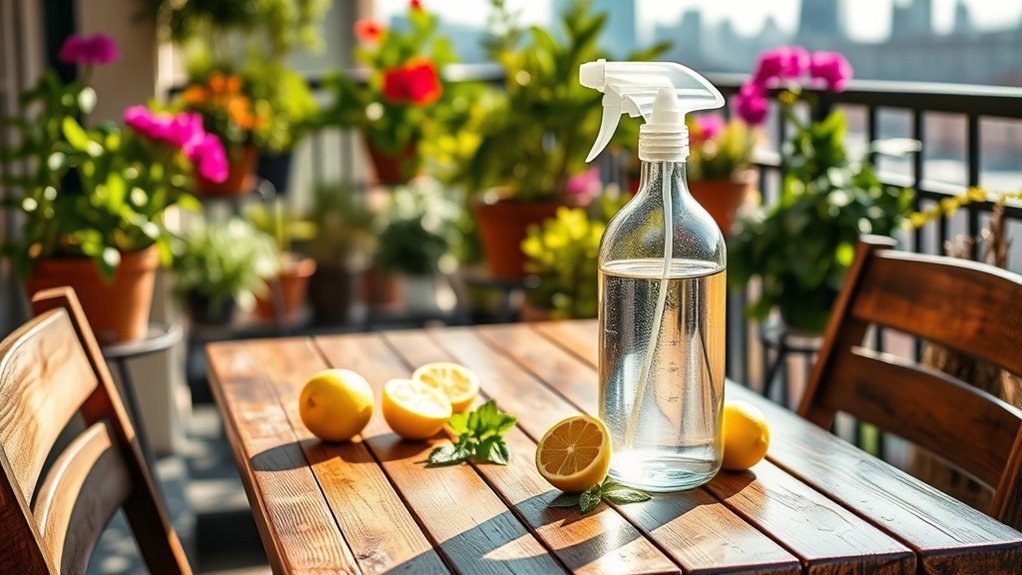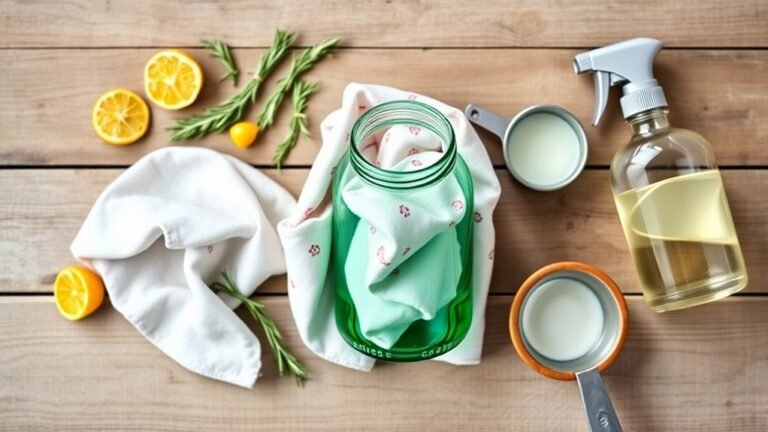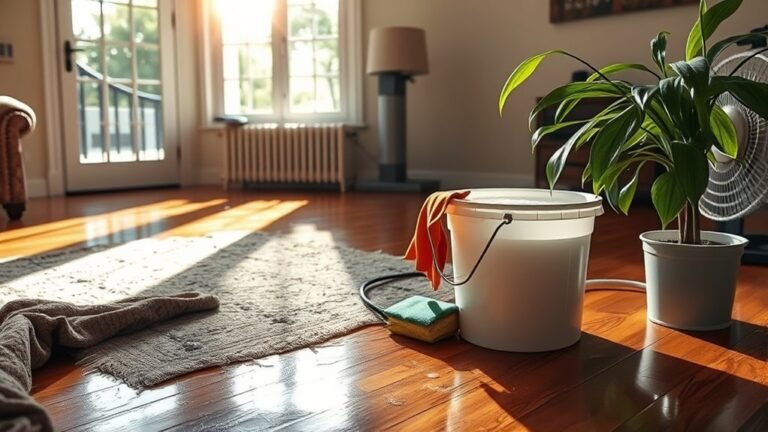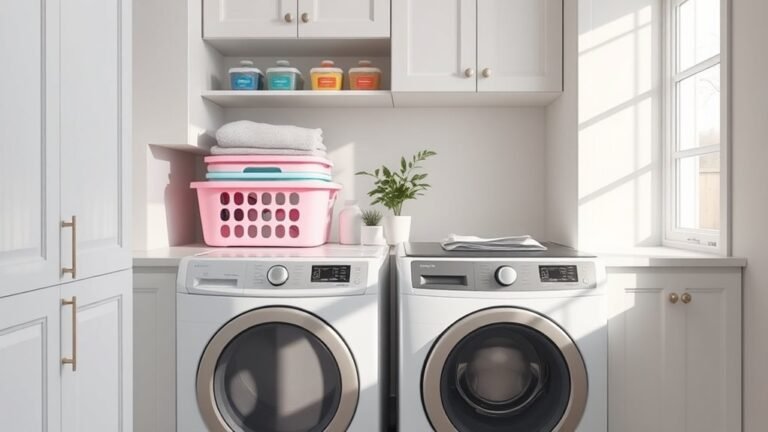Budget-Friendly DIY Cleaning Products for Balcony
You can easily make budget-friendly DIY cleaning products for your balcony using simple ingredients like white vinegar, baking soda, and liquid castile soap. These natural items tackle dirt, grease, mold, and stains without harsh chemicals. For example, mix vinegar and water for general surfaces, add baking soda for scrubbing power, and combine vinegar with lemon juice for tough grime. Using these safe, eco-friendly cleaners helps maintain a fresh, inviting outdoor space. Explore these DIY recipes and tips to keep your balcony spotless with ease.
Essential Ingredients for Homemade Balcony Cleaners

Before you start mixing your own balcony cleaners, it’s important to gather a few essential ingredients that are both effective and safe for outdoor surfaces. Opting for natural cleaning agents lets you avoid harsh chemicals, making eco friendly options a smart choice. White vinegar stands out for its ability to cut through grime and mold without damaging materials. Baking soda is another must-have; it acts as a gentle abrasive and deodorizer. Castile soap offers a plant-based cleanser that’s tough on dirt yet gentle on your balcony’s finish. Essential oils like tea tree or lemon add antibacterial properties and a fresh scent. By using these simple, natural ingredients, you maintain control over what you apply while protecting the environment and your outdoor space’s integrity.
All-Purpose Balcony Surface Cleaner Recipe
Creating an effective all-purpose balcony surface cleaner is simpler than you might think, and with just a few ingredients, you can tackle dirt, dust, and grime efficiently. Start by mixing one cup of white vinegar, one cup of water, and a tablespoon of liquid castile soap in a spray bottle. This blend offers a powerful yet gentle option for balcony cleaning that’s safe for most surfaces. The vinegar cuts through grease and mineral deposits, while castile soap lifts dirt without harsh chemicals. Spray generously on your balcony surfaces, let it sit for a few minutes, then scrub with a soft brush or cloth and rinse with water. This recipe is an excellent eco friendly solution, giving you freedom from commercial cleaners and their environmental impact.
Natural Degreaser for Outdoor Furniture

You can make a natural degreaser using simple ingredients like white vinegar, baking soda, and lemon juice to tackle grime on your outdoor furniture. Apply the solution with a soft cloth or spray bottle, letting it sit for a few minutes before scrubbing gently to avoid damaging surfaces. Store any leftover mixture in a sealed container away from direct sunlight to maintain its effectiveness.
Ingredients for Natural Degreaser
Although commercial degreasers can be effective, making your own natural degreaser for outdoor furniture is both safer and more environmentally friendly. You’ll want to gather a few key ingredients that harness the power of nature without harsh chemicals.
- White vinegar – Its acidity cuts through grease and grime effortlessly; the vinegar benefits include antibacterial properties.
- Citrus extracts – Lemon or orange extracts add a fresh scent and natural solvents to break down stubborn oils.
- Baking soda – Acts as a gentle abrasive to scrub away residue without damaging surfaces.
- Liquid castile soap – Provides a mild but effective cleaner that enhances the degreasing power.
With these ingredients, you’ll create a powerful, budget-friendly degreaser that’s gentle on your furniture and the planet.
Application Techniques for Furniture
Three simple steps will help you apply your natural degreaser effectively to outdoor furniture. First, start by removing loose dirt with a soft brush or cloth to prevent scratching. Next, generously spray or apply the degreaser onto the surface, ensuring you cover all greasy or grimy spots. Let it sit for about 10 minutes to break down built-up residue without damaging the material. Finally, scrub gently with a non-abrasive sponge or brush, then rinse thoroughly with clean water. Regularly using this method supports furniture maintenance, keeping your pieces in great shape while preserving outdoor aesthetics. This approach lets you enjoy your balcony’s freedom and charm without relying on harsh chemicals, making your furniture both clean and eco-friendly.
Storage Tips for Solution
After applying your natural degreaser and cleaning your outdoor furniture, proper storage of the leftover solution is key to maintaining its effectiveness. To keep your solution potent and ready for next time, follow these organization solutions:
- Use airtight storage containers made of glass or durable plastic to prevent contamination and evaporation.
- Label your containers with the date and contents, so you know when it’s time to make a fresh batch.
- Store the containers in a cool, dark place, away from direct sunlight and heat, to preserve the natural ingredients.
- Keep the solution out of reach of children and pets, ensuring safety while maintaining accessibility.
These simple storage tips will help you enjoy a clean balcony without wasting your DIY degreaser.
Homemade Glass Cleaner for Balcony Windows

When you want to keep your balcony windows sparkling without relying on commercial products, making your own glass cleaner is a simple and effective solution. This DIY recipe helps you avoid glass streaks while giving your window cleaning routine a fresh boost. Here’s an easy blend you can whip up at home:
| Ingredient | Quantity |
|---|---|
| White vinegar | 1 cup |
| Water | 1 cup |
| Rubbing alcohol | 1/2 cup |
| Liquid dish soap | 1 tsp |
Mix these ingredients in a spray bottle. Spray on windows and wipe with a microfiber cloth for crystal-clear results. This cleaner removes dirt and grime efficiently, letting you enjoy spotless balcony views without harsh chemicals.
Eco-Friendly Mold and Mildew Remover
Although mold and mildew can quickly take hold on your balcony, you don’t have to rely on harsh chemicals to tackle them. Using eco-friendly solutions not only protects your health but also supports mold prevention sustainably. Here’s a practical DIY remover:
- Mix one cup of white vinegar with one cup of water in a spray bottle.
- Add two teaspoons of baking soda for extra scrubbing power.
- Spray the solution directly onto affected areas and let it sit for 15 minutes.
- Scrub gently with a brush, then rinse with water and dry thoroughly.
This method breaks down mold safely without toxic residues, letting you reclaim your balcony while respecting the environment. Regular application helps prevent mold growth, keeping your outdoor space fresh and inviting.
DIY Floor Scrub for Balcony Tiles
To make an effective floor scrub for your balcony tiles, you’ll need simple ingredients like baking soda, liquid soap, and warm water. Start by mixing these in the right proportions to create a paste that’s tough on dirt but gentle on tiles. Follow the step-by-step preparation process to guarantee your scrub cleans thoroughly without damaging the surface.
Essential Ingredients Needed
Because balcony tiles are exposed to outdoor elements, you’ll need ingredients that effectively tackle dirt, grime, and mildew without damaging the surface. Opting for natural cleaning and eco friendly alternatives protects both your balcony and the environment. Here are four essential ingredients you’ll want to gather:
- Baking Soda – A gentle abrasive that lifts dirt and neutralizes odors.
- White Vinegar – Cuts through grime and acts as a natural disinfectant.
- Liquid Castile Soap – Provides effective cleaning power without harsh chemicals.
- Water – The base to mix your scrub, ensuring it’s easy to apply and rinse off.
With these ingredients, you’re set to make a powerful yet safe floor scrub that keeps your balcony tiles fresh and spotless.
Step-by-Step Preparation Process
Once you have all your ingredients ready, you’ll find that mixing your DIY floor scrub is straightforward and quick. Start by combining half a cup of baking soda with a quarter cup of liquid castile soap in a bowl. These cleaning supplies serve as excellent eco friendly alternatives to harsh chemicals. Next, add a few drops of essential oils for a pleasant scent and extra antibacterial power. Stir the mixture until it forms a thick paste. When ready to use, apply the scrub directly onto your balcony tiles with a brush or sponge, focusing on stubborn spots. Rinse thoroughly with water afterward. This step-by-step preparation process guarantees you create an effective, budget-friendly floor scrub that’s safe for both your balcony and the environment.
Stain Removal Solutions for Balcony Fabrics
Stubborn stains on balcony fabrics can quickly diminish the comfort and appearance of your outdoor space. To keep your fabrics looking fresh without breaking the bank, focus on effective stain removal solutions that also emphasize fabric care and stain prevention.
- Mix equal parts white vinegar and water to create a gentle, natural stain remover ideal for most fabrics.
- Apply a paste of baking soda and water to tough stains, letting it sit before scrubbing lightly.
- Use mild dish soap diluted in warm water for everyday cleaning and immediate stain treatment.
- Always blot stains instead of rubbing to prevent fabric damage and spread.
Tips for Maintaining a Clean and Fresh Balcony Environment
Keeping your balcony fabrics clean is just one part of maintaining an inviting outdoor space. To keep your balcony fresh, regularly sweep away dirt and debris, especially under furniture and in corners. For balcony plant care, water plants early in the morning to prevent mildew and wipe leaves to remove dust. Rotate plants periodically to guarantee even sun exposure. When it comes to outdoor decor maintenance, clean surfaces with a mild DIY solution—like diluted vinegar or gentle soap—to avoid buildup and fading. Remove cobwebs and check for pests frequently. Finally, make certain of proper ventilation by opening doors and windows when possible; it helps reduce moisture and keeps the air fresh. These simple steps let you enjoy a clean, vibrant balcony that feels like an extension of your home.
Frequently Asked Questions
How Long Do DIY Cleaning Products Typically Last When Stored?
They say, “A stitch in time saves nine,” and that applies here—proper storage extends your DIY cleaning products’ shelf life. Typically, homemade cleaners last about one to three months if stored in airtight containers, away from direct sunlight and heat. To maximize longevity, keep them in cool, dark places and label each with the preparation date. This way, you’ll maintain their effectiveness and enjoy the freedom of knowing your cleaning supplies are ready when you need them.
Are These Homemade Cleaners Safe for Pets on the Balcony?
You’ll want to prioritize pet friendly ingredients when making your own cleaners to guarantee cleaning product safety. Natural components like vinegar, baking soda, or lemon juice are generally safe and effective. Avoid harsh chemicals like bleach or ammonia, which can harm your furry friends. Always test a small area first and keep pets away until the surface is fully dry. This way, you can clean freely without risking their health.
Can I Use These Cleaning Solutions on Painted Balcony Surfaces?
You can use these cleaning solutions on painted balcony surfaces, but you’ll want to take into account paint durability and surface compatibility first. Some homemade cleaners might be too abrasive or acidic, potentially dulling or damaging the paint. Always test a small, hidden spot before applying widely. If the paint is delicate or older, opt for gentler formulas with mild ingredients to maintain the finish while keeping your balcony clean and fresh without restrictions.
What Is the Best Way to Store Leftover DIY Cleaning Mixtures?
Like a treasure chest preserves its jewels, storing your leftover DIY mixtures right keeps their power intact. Use glass containers or spray bottles for airtight sealing, preventing spills and contamination. Label each with contents and date, so you know what’s inside and when it was made. Keep them in a cool, dark place away from sunlight or heat to maintain their effectiveness. This way, you stay free from waste and ready for any cleaning task.
How Often Should I Deep Clean My Balcony Using These Products?
You should aim to deep clean your balcony at least once every season, following a seasonal cleaning schedule to keep it fresh and inviting. Balcony cleaning frequency depends on your local climate and usage, but quarterly deep cleans help prevent buildup of dirt, mold, and grime. Regular maintenance between deep cleans can extend time between major scrubs, giving you the freedom to enjoy your space without constant upkeep stress.






